King of Saudi Arabia
| King of Saudi Arabia | |
|---|---|
| ملك المملكة العربية السعودية | |
|
| |
| Incumbent | |
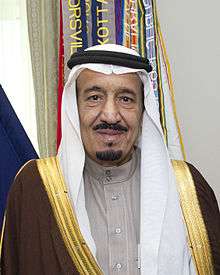 | |
|
Salman since 23 January 2015 | |
| Details | |
| Style | The Custodian of the Two Holy Mosques |
| Heir apparent | Muhammad bin Nayef |
| First monarch | Abdulaziz (Ibn Saud) |
| Formation | 22 September 1932 |
| Residence | King’s Palace, Riyadh[1] |
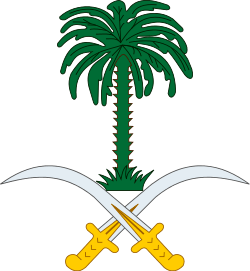 |
| This article is part of a series on the politics and government of Saudi Arabia |
| Basic Law |
| Foreign relations |
The King of Saudi Arabia is Saudi Arabia's head of state and absolute monarch (i.e. head of government). He serves as the head of the Saudi monarchy — House of Saud. The King is called the Custodian of the Two Holy Mosques (خادم الحرمين الشريفين). The title, which signifies Saudi Arabia's jurisdiction over the mosques of Masjid al Haram in Mecca and Masjid al-Nabawi in Medina, replaced His Majesty (صاحب الجلالة) in 1986.
History
King Abdulaziz (also known as Ibn Saud) began conquering today's Saudi Arabia in 1902, by restoring his family as emirs of Riyadh. He then proceeded to conquer first the Nejd (1922) and then the Hejaz (1925). He progressed from Sultan of Nejd, to King of Hejaz and Nejd, and finally to King of Saudi Arabia in 1932.
Succession
The kings since Ibn Saud's death have all been his sons, and all likely immediate successors to the reigning King Salman will be from his progeny. Sons of Ibn Saud are considered to have primary claim on the throne of Saudi Arabia. This makes the Saudi monarchy quite distinct from Western monarchies, which usually feature large, clearly defined royal families and orders of succession. The current Crown Prince is the first grandson of Ibn Saud to be in the line of succession.
Legal position
Saudi Arabia is ruled by Islamic law (Sharia) and purports to be an Islamic state, but many Muslims see a hereditary monarchy as being a discouraged system of government in Islam.[2]
Other functions
The King of Saudi Arabia is also considered the Head of the House of Saud and Prime Minister. The Crown Prince is also the "Deputy Prime Minister". The kings after Faisal have named a "second Deputy Prime Minister" as the subsequent heir after the Crown Prince.
Kings of Saudi Arabia (1932–present)
| Name |
Lifespan |
Reign start |
Reign end |
Notes |
Family |
Image |
|---|---|---|---|---|---|---|
Abdulaziz
|
26 November 1876 – 9 November 1953 (aged 76) | 22 September 1932 | 9 November 1953 | Son of Abdul Rahman bin Faisal and Sarah Al Sudairi | Saud | 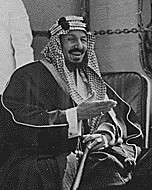 |
Saud
|
12 January 1902 – 23 February 1969 (aged 67) | 9 November 1953 | 2 November 1964 (deposed.) |
Son of Ibn Saud and Wadhah bint Muhammad bin 'Aqab | Saud | 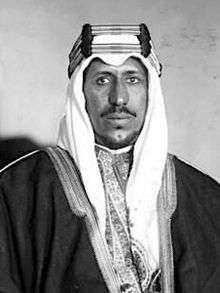 |
Faisal
|
14 April 1906 – 25 March 1975 (aged 68) | 2 November 1964 | 25 March 1975 (assassinated.) |
Son of Ibn Saud and Tarfa bint Abduallah bin Abdulateef al Sheekh | Saud | .jpg) |
Khalid
|
13 February 1913 – 13 June 1982 (aged 69) | 25 March 1975 | 13 June 1982 | Son of Ibn Saud and Al Jawhara bint Musaed bin Jiluwi | Saud |  |
Fahd
|
16 March 1921 – 1 August 2005 (aged 84) | 13 June 1982 | 1 August 2005 | Son of Ibn Saud and Hassa bint Ahmed Al Sudairi | Saud | 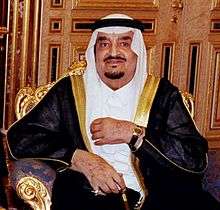 |
Abdullah
|
1 August 1924 – 23 January 2015 (aged 90) | 1 August 2005 | 23 January 2015 | Son of Ibn Saud and Fahda bint Asi Al Shuraim | Saud |  |
Salman
|
31 December 1935 | 23 January 2015 | Incumbent | Son of Ibn Saud and Hassa bint Ahmed Al Sudairi | Saud |  |
Current heirs-presumptive
- Crown Prince Muhammad bin Nayef, born 30 August 1959; son of Nayef bin Abdulaziz and Al Jawhara bint Abdulaziz bin Musaed bin Jiluwi Al Saud, Grandson of Ibn Saud and Hassa bint Ahmed Al Sudairi.
- Deputy Crown Prince Mohammad bin Salman, born 1985 (age 30–31); son of King Salman and Fahda bint Falah bin Sultan Al Hithalayn.
Timeline

Royal Standard
The Royal Standard consists of a green flag, with an Arabic inscription and a sword featured in white, and with the national emblem embroidered in gold in the lower right canton.

The script on the flag is written in the Thuluth script. It is the shahada or Islamic declaration of faith:
- لَا إِلٰهَ إِلَّا الله مُحَمَّدٌ رَسُولُ الله
- lā ʾilāha ʾillā-llāh, muhammadun rasūlu-llāh
- There is no other god but God, Muhammad is the messenger of God.[3]
See also
References
- ↑ Kings of the World – Rich Living Monarchs and their Royal Residences
- ↑ Rabasa, Angel (2004). The Muslim world after 9/11. Rand Corporation. p. 164. ISBN 978-0-8330-3712-1.
- ↑ "About Saudi Arabia: Facts and figures". The Royal Embassy of Saudi Arabia, Washington D.C. Retrieved 24 April 2012.